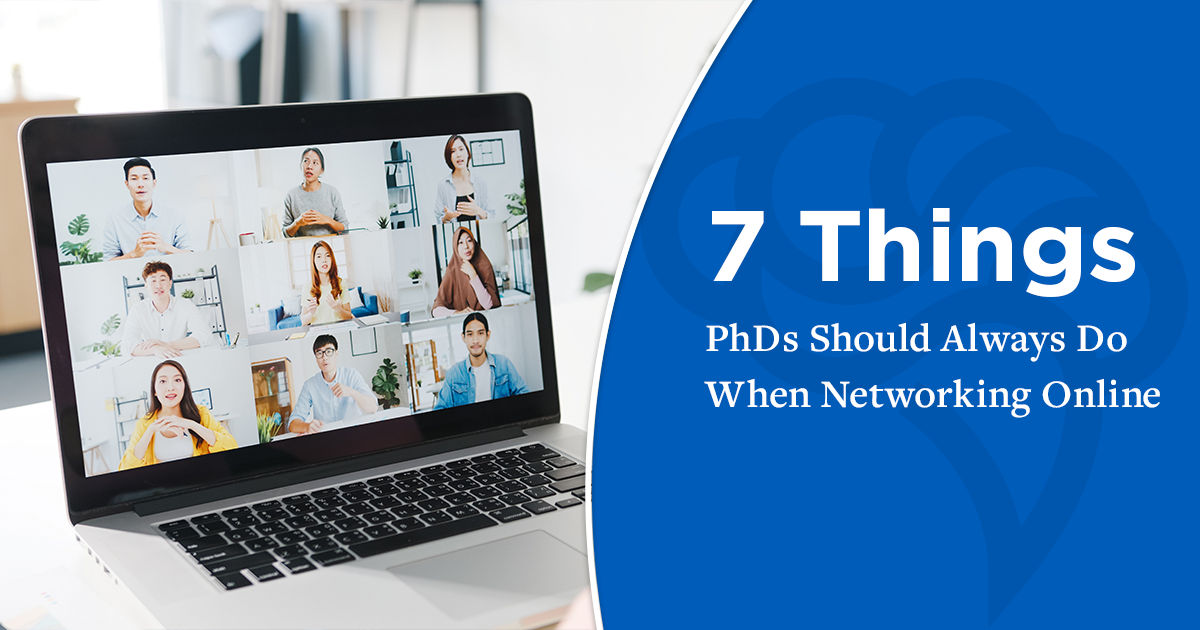7 Things PhDs Should Always Do When Networking Online

If you want to get a PhD-level industry position, you need to set up a networking strategy and invest in your professional relationships.
You can build rapport with someone else by networking in person, either at networking events, or over a cup of coffee.
However, online networking is another powerful tool you can use to reach out to industry professionals and start a conversation.
Do you know how to turn a LinkedIn connection into a job referral? If you don’t, you’re in trouble and are probably missing out on some great opportunities.
Take for example the following story a member shared with me after their second transition:
I have accepted an offer for a data scientist position. This is my second transition.
What I learned from this experience is that networking is the key to getting a job fast. It’s way more effective than spending time on your resume.
I find out about this opportunity by reaching out to other members of the association who connected me with the right people.
Being able to network online was crucial as all my transition process was done during the pandemic.
So, let’s talk about the steps you need to take to put in place an effective online networking strategy.
Before Reaching Out To People, Identify The Companies You Want To Work With
In a nutshell, online networking is about finding employees who work at your companies or interest, reaching out to them, adding value to them, and asking to set up an informational interview that will hopefully lead to a referral.
Before you can reach out to people, you need to determine your companies of interest. Otherwise you’re just shooting in the dark.
Most job candidates think the best way to find companies that they can work at is by Googling or using some other search algorithm to search for top companies in a given city or industry sector.
These keywords are far too general, which makes them more competitive. So, they have a low chance of helping you find companies that are right for you.

Instead of focusing on big companies, I recommend you focus on small and middle-sized companies.
Keep in mind that scales are different in academia and industry, a small company in industry can have up to 1,500 employees, whereas a small academic lab usually has around 5 students.
Instead of using general keywords like “top” and “best” that will give you no results, be more specific.
Focus on the company size, the type of company or industry sector, and the location in a single search. Use long tail keywords like “small biotechs in Boston.”
You will probably get results with lists of companies you have never heard of but could be a good match.
Once you have a list of target companies, you can go to LinkedIn and look for them. Most companies have a LinkedIn profile page.
Once you find the right company, you can go to the “people” tab, which will show you a list of employees with whom you can connect.
7 Actions To Ensure You Don’t Waste Your Efforts During Online Networking
Now that you know how to find your target companies and the employees who work for them, you’re probably thinking you’re ready to start sending LinkedIn connections and setting up informational interviews.
But there are some things you should consider first.
For example, what’s your strategy? What type of people should you reach out to? When’s the right time to ask for an informational interview?
If you start sending connection requests without considering these questions, you might not get the connection, or worse, burn a bridge.
Instead, make sure to always consider the following actions when networking online.
1. Always be professional
This should be your golden rule from the moment you commit to finding an industry job.
Everytime you send a connection request, answer a message, follow up, set up an informational interview, or ask for a referral, you should be professional.
This includes using industry language, but also showing the other that you understand they’re busy and value their time.
Always be polite and professional, and never send passive aggressive messages like “Hey, just seeing if you saw my last message.”
Don’t spam your connections sending messages everyday – once every two weeks is the norm in industry.
And first and foremost, make it all about them, don’t start a conversation by talking about yourself or asking them to review your resume.
2. Reach out to the right people
Many PhDs think that the best people to reach out to are the chairmen or the directors of their target companies because they have the most power and can make high level decisions.
But these are also the people who are the busier, get the most messages, and are the least likely to reply to a connection request, especially from someone they don’t know.
Instead, you should focus on the people working in cross functional positions to your target job.
This means, people in your exact target position or those who work side by side with that department but are at the same level of hierarchy.

These people are more likely to accept your connection request and start building a relationship with you.
3. Tap into your existing network
There’s somebody in your network right now who can get you a job.
When most PhDs think about networking, they think about reaching out for the first time to some perfect connection who will refer them to their dream job.
They almost never consider the possibility of having met the person who will set them up for success already. This is a mistake.
It’s much more difficult to build rapport and ask for something from someone you don’t know or have nothing in common with than to reignite an old relationship or to reach out to someone with whom you have something in common.
So, start by looking at your current connections, your current alumni networks or associations, even LinkedIn groups that you’re a part of.
You can look at these people on LinkedIn and see if one of them works at your target company.
Even if these people don’t know you personally, the fact that you have something in common to mention in your connection request will make them more likely to read your message and start a conversation.
Never underestimate the power of your current network. Don’t let yourself believe that you don’t know anyone, you already have valuable connections.
And this is where you should start building your online network.
4. Avoid cold contacting by asking for introductions
Cold contacting industry employees is hard. Because they already have a job, they’re not as active on LinkedIn.
This means you probably will have to send several messages before you get an answer.
A good way to bypass that is to ask for an introduction from a shared connection.
When you look at the employees of a given company, Linkedin will let you know if you have any first or second-degree connections.
First-degree connections are people you are connected with and second-degree connections are people who are connected to your first-degree connections.

If you find a second-degree connection at one of your target companies, you can ask your shared connection for an introduction.
This will make your target connection more likely to respond and help you build rapport with them.
To ask for an introduction, write to your first-degree connection and let them know why you want them to introduce you. Let them know that this person works at a company you’re interested in and you would like to ask them two or three questions about their job.
To make things even easier for your first-degree connection, you can send an example script for the introduction. Tell them you know they’re busy, so you wrote a script that they can modify in any way they like or write one from scratch.
5. Always add value first
Adding value first (AVF) is my mantra. Everytime you send a message to a connection, you should add value. Only once you’ve added value and built rapport, you can ask for something in return.
Many PhDs think that this is very difficult to do. That they have no value to add. This is simply not true.
You don’t need to have a job or money to add value to someone. You just need to treat them as you would like to be treated.
You can show appreciation as a colleague, compliment their work or career progress, make a recommendation, ask for their personal opinion, or offer to make an introduction.
These might seem like small things, but they will make a big difference when it comes to building relationships.
Every time you reach out to somebody, you should add value in a different way. Remember to always be kind and professional.
It’s common for people to miss some of your messages. But once their eye catches one of them, they will go back and search your name.
Once they see that you’re kind and add value in all your messages, they’re going to feel the need to help you.
But if all your messages are the same or focus on what you need instead of adding value. Your connection won’t feel any interest for you and might even mark you as spam.
6. Use the right structure in your messages
How you structure your messages will have a big impact on whether or not you get and answer and are able to keep the conversation going.
The most important factor to ensure a reply is the first line of your LinkedIn message or the email subject line that you use.
Most people use general headlines like “how are you” or “your recent paper.” These are not interesting enough, people won’t feel compelled to keep reading.
Instead, you should use specific headlines that make it clear that your message will add value to them.

For example, if you know your connection likes coffee, you can use something like “best dark roast coffee in town.” At the same time, keep your headlines short, 7 words at most.
If you haven’t built rapport with this person yet, look at their profile to find something they’re interested in that’s specific enough for your headline to be engaging.
Use their name in the body of the message. Avoid general salutations like “dear Sir/Madam,” this will make your message look like spam.
Then, add value. Talk about their recent promotion, an article they just published, or a recent post.
Never forget your audience. The body of the message should focus on the person receiving the message, not the person writing the message. This is how you build a professional relationship.
At the end of the message, add a short PS line with a very simple question.
People always read the PS of a message, it gives them a sense of completion. By adding a question in the last line, you increase your chances of getting a response, especially if it’s a very simple question they can’t resist answering.
7. Identify the right moment to ask for an informational interview
Knowing when to ask for an informational interview is crucial when it comes to bringing a professional relationship to the next level.
You don’t want to ask for it right away, but you also don’t want to let the right moment pass because then your connection will feel that the relationship has gotten stuck and might lose interest.
Once you have exchanged a couple of messages and built rapport with this person, you will notice they almost always answer your messages and start asking about you and your career.
This is the best moment to ask for an informational interview. The key here is not to mention the term informational interview.
Instead, ask them if you can arrange a quick call to ask two specific questions about their job.
Concluding Remarks
Online networking is a powerful tool you can use to reach out to industry professionals and start a conversation that can lead you to a job referral. Especially if you make it in the right way. To ensure you’re taking advantage of this great tool, start by identifying the companies you want to work with and use LinkedIn to find potential connections to reach out to. Then, follow these 6 practices to increase your chances of having positive answers: always be professional and kind, reach out to people with cross-functional jobs form your target positions, tap into your current network, ask for introductions to avoid having to cold contact your target connections, always add value, and structure your messages in the right way. This will ensure you get the conversation going and can ask for an informational interview and even a referral.
If you’re ready to start your transition into industry, you can apply to book a free Transition Call with our founder Isaiah Hankel, PhD or one of our Transition Specialists. Apply to book a Transition Call here.

ABOUT ISAIAH HANKEL, PHD
CEO, CHEEKY SCIENTIST & SUCCESS MENTOR TO PHDS
Dr. Isaiah Hankel is the Founder and CEO of Cheeky Scientist. His articles, podcasts and trainings are consumed annually by millions of PhDs and other professionals in hundreds of different countries. He has helped PhDs transition into top companies like Amazon, Google, Apple, Intel, Dow Chemical, BASF, Merck, Genentech, Home Depot, Nestle, Hilton, SpaceX, Tesla, Syngenta, the CDC, UN and Ford Foundation.
Dr. Hankel has published 3X bestselling books and his latest book, The Power of a PhD, debuted on the Barnes & Noble bestseller list. His methods for getting PhDs hired have been featured in the Harvard Business Review, Nature, Forbes, The Guardian, Fast Company, Entrepreneur Magazine and Success Magazine.
More Written by Isaiah Hankel, PhD































